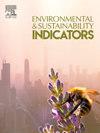Using natural capital accounting for biodiversity offset policy: a case study from the Australian Capital Territory
IF 5.4
Q1 ENVIRONMENTAL SCIENCES
引用次数: 0
Abstract
Biodiversity offsetting aims to balance biodiversity conservation against demand for land required for development, while natural capital accounting (NCA) is an information system for integrated environmental-economic decision-making. Many countries use both, but to date, NCA is untested for biodiversity offset policy. We rectify this using the Australian Capital Territory (ACT), a subnational jurisdiction using offsetting and facing global challenges common to offset implementation and biodiversity conservation. Hybrid land cover, land use and ecosystem extent accounts for offset areas, development areas, and protected areas were produced for 2010 to 2020. These identified 2217 ha of offsets required for 26 developments, mainly impacting natural temperate grasslands (NTG) and box-gum grassy woodlands (BGGW). Assessing net biodiversity changes was challenging because changes in ecosystem extent based on land cover are open to interpretation, and ecosystem condition accounts couldn't be produced. Between 2010 and 2020, land cover associated with NTG and BGGW declined across the ACT: 3011 ha fall in BGGW-short vegetation and 5761 ha fall in BGGW-open woodland. ACT offset areas were typically within land zones unlikely to be developed, and the area for new offsets is limited (9828 ha). While the data challenges of assessing offset policy identified in this study and others are a barrier to account production and use for offset policy, we conclude that accounting could inform offset policies in the ACT and globally by systematically linking biodiversity offsets to ecosystem extent and condition, allowing consistent net biodiversity changes assessment and providing a path to international standardisation of offset measurement and reporting.
利用自然资本核算生物多样性补偿政策:来自澳大利亚首都地区的案例研究
生物多样性补偿旨在平衡生物多样性保护与发展所需土地的需求,而自然资本核算(NCA)是环境经济综合决策的信息系统。许多国家都使用这两种方法,但迄今为止,NCA在生物多样性抵消政策方面还没有经过测试。我们使用澳大利亚首都直辖区(ACT)来纠正这一点,这是一个使用抵消的次国家管辖权,面临着抵消实施和生物多样性保护共同面临的全球挑战。混合土地覆盖、土地利用和生态系统范围占抵消区、开发区和保护区2010 - 2020年。这些研究确定了26个开发项目需要2217公顷的补偿,主要影响自然温带草原(NTG)和盒胶草林地(BGGW)。评估净生物多样性变化具有挑战性,因为基于土地覆盖的生态系统范围变化具有开放性,并且无法产生生态系统条件解释。2010年至2020年期间,澳大利亚首都地区与NTG和BGGW相关的土地覆盖减少:BGGW短植被减少3011公顷,BGGW开放林地减少5761公顷。澳大利亚首都圈抵消区通常位于不太可能开发的土地区内,用于新抵消的面积有限(9828公顷)。虽然本研究和其他研究中确定的评估抵消政策的数据挑战是抵消政策核算生产和使用的障碍,但我们得出结论,通过系统地将生物多样性抵消与生态系统范围和状况联系起来,允许一致的净生物多样性变化评估,并为抵消测量和报告的国际标准化提供途径,会计可以为澳大利亚和全球的抵消政策提供信息。
本文章由计算机程序翻译,如有差异,请以英文原文为准。
求助全文
约1分钟内获得全文
求助全文
来源期刊

Environmental and Sustainability Indicators
Environmental Science-Environmental Science (miscellaneous)
CiteScore
7.80
自引率
2.30%
发文量
49
审稿时长
57 days
 求助内容:
求助内容: 应助结果提醒方式:
应助结果提醒方式:


